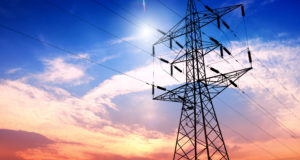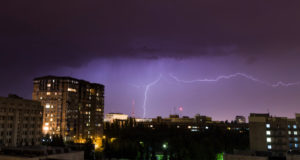“For as the lightning cometh forth from the east, and is seen even unto the west; so shall be the coming of the Son of man.” (Matthew 24:27)
Of course, in this context, I hasten to add, “But of that day and [that] hour knoweth no man, no, not the angels which are in heaven, neither the Son, but the Father.” (Mark 13:32)
 (After all, I’m not in the prognosticating business. From what two evangelists record Jesus as saying on the subject, neither was he—at least not in any mark-your-calendar kind of way.)
(After all, I’m not in the prognosticating business. From what two evangelists record Jesus as saying on the subject, neither was he—at least not in any mark-your-calendar kind of way.)
So no, I am not really talking here about the Second Coming—rather more prosaically, using a colorful image from one such eschatological passage to introduce two different kind of spectacular electrical eruptions and disruptions.
Too Darn Hot
Solar storms could cause one such potential disaster. We have been able to track solar storms into cycles, across a range of intensity, and current models predict the next maximum—a potential “big one—for 2012. One whopper came in March of 1989. Imagine a blast of hot, charged solar gas a million miles wide. Now imagine that blast—a “coronal mass ejection”—heading right toward Earth. It took three days to reach us. Earth’s geomagnetic field sizzled into an electromagnetic storm. Texans saw the Northern Lights.
These storms generate electromagnetic pulses (EMP), whose intense magnetic field may induce ground currents that over-amp the power grid: in this case, Québec got zapped. Six million Canadians and Americans were without power for nine hours or more. Opinion varies as to the potential scale of any future such hit to the grid.
The worst solar-origin case for EMPs would be a hot, fast coronal mass ejection whose magnetism was oriented opposite to Earth’s magnetic field.
Major static.
Major sparking.
One of those solar super storms is expected as soon as the next ten years, and no later than the next hundred.
The Nuclear Option
Another way to zap electronic devices, and possibly the electrical grid, is to set off an atomic bomb a minimum of 25 miles up (on up to 500 miles) in order to ionize the atmosphere. Under these circumstances, each EMP would pulse in three waves—their timing, duration, and effects determined by the physics of gamma rays. The extent of the pulses on Earth would depend on bomb size, detonation altitude, and particulars of bomb design.
Some claim catastrophic nationwide damage would be easy to achieve with this method. Others suggest major damage would require the equivalent of one of the big Soviet H-bombs, requiring massive infrastructure and currently not even being produced by nations—including those with active weapons-capable nuclear programs—let alone non-national organizations. (Production of weapons that expensive rose from the special conditions of Cold War ideology and tactics, in which the U.S. deliberately pressed the Soviet Union to bankrupt itself on its military. The USSR happily complied, and both nations squandered enormous amounts of resources in ways we feel to this day.)
As it happens, the U.S. tested this phenomenon in 1962 with a 1.4-megaton H-bomb, the Starfish Prime, at a height of 250 miles. The pulse shorted out streetlights in Oahu, about 900 miles to the northeast; Hawaii’s grid was not otherwise affected.
How Even Small Accidents Can Scale Up
The U.S. relies on three regional grids: Texas has its own, another covers the East and Midwest, another the West. Any one grid going out in its entirety—there can be a domino or ripple effect from the initial failure—could cause national disruption and expense, and if more than one were to take a major hit? Let’s put it this way—it will not be a “The Day the Earth Stood Still” event, with major electronic disruptions that don’t affect hospitals and planes in flight.
As one example of the scale of a cascading failure, August 2003’s blackout hit Great Lakes, Canada and states from Massachusetts to Michigan. Fifty-five million people depended on the 100 power plants that toppled one after another. Grid power was unavailable for a minimum of two days, with pockets where the outage lasted much longer. Economic costs were assessed at six billion dollars, mostly from lost work. And no big atmospheric EMP was needed for that degree of disruption. The source was traced to such a mundane maintenance issue as overheated lines stretching and sagging into under-trimmed trees.
(The instantaneous spread of such a local occurrence into a regional event could have been headed off in the same way geomagnetic storm effects can be minimized through retrofitting with dampers to offload surges into the ground. The expense of that kind of program compares favorably to the nearly $120 billion that “normal” blackouts cost each year.)
Prepare for the Worst in the Best Way
Back in 2003, with media stations, traffic lights, and urban train systems down across the northeast, and water supplies threatened, people had to learn to make do, and most did admirably. Few deaths or injuries can be traced directory to the blackout. Significantly, those deaths were from candle fires, and from carbon monoxide poisoning from home generators.
So it makes sense to be prepared. Preparation, however, means more than—or something completely different from—buying an internal-combustion generator and stocking up on fuel. It might, for example, mean an integrated, safe, possibly low-tech approach to energy consumption and generation. It might mean checking out the inherent safety and risk features of candle and holder types, and holding periodic lamp and candle safety drills in the home for young and old alike. It might mean doing whatever you need to do to be prepared.
Other articles in this issue:
If you liked this article you may be interested in this product from our sponsor.

 Off The Grid News Better Ideas For Off The Grid Living
Off The Grid News Better Ideas For Off The Grid Living



